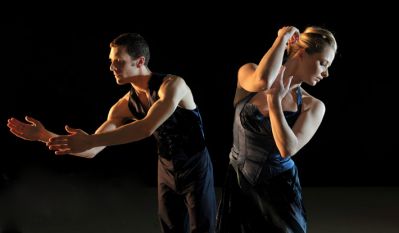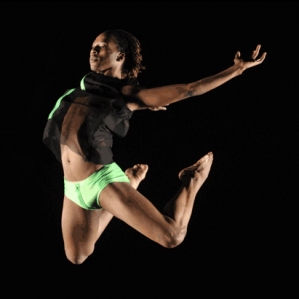The Art of Touch/ Rainforest/ A Linha Curva, Rambert, Sadler's Wells | reviews, news & interviews
The Art of Touch/ Rainforest/ A Linha Curva, Rambert, Sadler's Wells
The Art of Touch/ Rainforest/ A Linha Curva, Rambert, Sadler's Wells
Two rich dishes of past contemporary masters plus a fast food sugar-rush
There are occasionally pieces of dance that you just want not to have to scribble notes about, just to watch and enjoy through your senses, not perming it all through the verbal brain. Siobhan Davies’s The Art of Touch is one of those, and when her company went into something of a creative abeyance to focus on producing a new dance community centre, this was one of Davies’s many gems of dance poetry that I feared we might never be able to bask in again.
Fortunately last night Rambert turned up, under Mark Baldwin’s sensitive direction, picking up this 1995 beauty and one of Merce Cunningham’s visual landmarks on a programme that suggests a gap in skill, imagination and sensory perception between two doyens of previous generations of contemporary choreography and an instant-fried-chicken merchant of now.
 The Art of Touch is about touch, keyboard touch, personal touch. Against dark gold-leaf walls (designed by David Buckland), lit with cunning changes of light (Ian Beswick) that are always mysterious, magical, Davies’s three women and four men cast off a reel of speed and flicking steps that mirror the plucking and timbre changes of Scarlatti’s harpsichord sonatas, and also pick up on the isolating emotions cast by Matteo Fargion’s answering harpsichord Setti Canzoni (Six Songs), composed to complement Scarlatti 250 years later. (Right: Jonathan Goddard and Gemma Nixon pictured by Hugo Glendinning.) The details in Davies’s piece are a delight, hands going through myriad mercurial messages, bodies scything in great swoops from fore to aft, and the relish with which Rambert’s dancers pick them up and play with them is a demonstration of what the career in dance is intended to encompass - pleasure, stimulation, challenge.
The Art of Touch is about touch, keyboard touch, personal touch. Against dark gold-leaf walls (designed by David Buckland), lit with cunning changes of light (Ian Beswick) that are always mysterious, magical, Davies’s three women and four men cast off a reel of speed and flicking steps that mirror the plucking and timbre changes of Scarlatti’s harpsichord sonatas, and also pick up on the isolating emotions cast by Matteo Fargion’s answering harpsichord Setti Canzoni (Six Songs), composed to complement Scarlatti 250 years later. (Right: Jonathan Goddard and Gemma Nixon pictured by Hugo Glendinning.) The details in Davies’s piece are a delight, hands going through myriad mercurial messages, bodies scything in great swoops from fore to aft, and the relish with which Rambert’s dancers pick them up and play with them is a demonstration of what the career in dance is intended to encompass - pleasure, stimulation, challenge.
A male-female couple (Angela Towler and Jonathan Goddard) with intimate disagreements on their mind, as is clear from their very delicate adagio duet of courtly but emotionally complex gestures, mirror two soloists isolated from the others (Pieter Symonds and Eryck Brahmania) who have Fargion’s modern music for their muse. These enigmatic semi-narratives run in parallel and sometimes in mesh with the others, leaving much that is allusive, and much that seems simply a luscious, fleeting reaction to the physical sensation of the harpsichord music, its plucking, vibrating, striking of quill against gut string.
On the way you have to fall prostrate in admiration for Towler’s ethereal tremulousness and for the phenomenal Pieter Symonds with tumbling auburn ringlets (she used to be blonde, didn’t she?), who has a back as responsive as a violin string and a bold flying jeté as sudden as an arrow sprung from a bow.
Symonds shines every time she appears, distinctive, characterful, a chameleon in technique, making her mark just as much in a brief entry in the disorientating, druggy 1968 Rainforest of Merce Cunningham, where a small handful of languid dancers in nude-look torn leotards try to stir themselves amid the LSD landscape of silver floating pillows created by Andy Warhol for a gallery in 1966.
The dreamy, slo-mo indolence of the sporadic dancing amid the captivating slow motion of the silver pillows, coupled with a soundscape by David Tudor that is all about rustles, bird calls, animalistic roars and electronic insectoid hums, make for a highly romantic and cohesive (for Cunningham) evocation of a narcotic forest trip. The occasionally glimpsed dancers start slow and reluctant to move from their bedtime cuddles, and end in some kind of cold turkey frenzy by one of them. It’s fascinating, oddly removed from now - part ancient Egyptian, part hippie trip. I don’t think it’s Cunningham’s greatest physical invention that I’ve seen of Rambert's nine acquisitions from his catalogue, but it’s a pretty period piece.
 Finally, after these two lipsmacking treats, Baldwin - who often steps on his own feet - programmed some fast food by Itzik Galili, an Israeli who went on holidays to Brazil. Ho hum, shake yer ass in tight little Lycra pants and a slit mesh vest, bang some drums behind, and hunker down pelvis-forward, shoulders-behind, and shriek happily. Lots and lots of Rambert dancers line up under 49 coloured lights (reader, I counted them) and shake their tushes as if inventing limbo. (Left: Mbulelo Ndabeni pictured by Hugo Glendinning.) A Linha Curva is the dance equivalent of Dave Brubeck’s Take Five in the tube - each busker thinks this is a great new tune, but each passer-by has heard it a thousand times before.
Finally, after these two lipsmacking treats, Baldwin - who often steps on his own feet - programmed some fast food by Itzik Galili, an Israeli who went on holidays to Brazil. Ho hum, shake yer ass in tight little Lycra pants and a slit mesh vest, bang some drums behind, and hunker down pelvis-forward, shoulders-behind, and shriek happily. Lots and lots of Rambert dancers line up under 49 coloured lights (reader, I counted them) and shake their tushes as if inventing limbo. (Left: Mbulelo Ndabeni pictured by Hugo Glendinning.) A Linha Curva is the dance equivalent of Dave Brubeck’s Take Five in the tube - each busker thinks this is a great new tune, but each passer-by has heard it a thousand times before.
The trouble is, all those valuable “Young Audiences” haven’t lived long enough to realise, and they scream lustily at the bottom-wiggling and drum-banging, and so Rambert carry on doing this thin, clichéd, touristy piece, and dismissing those of us who point out the clichés as boring old party-poopers.
- Rambert's triple bill is at Sadler's Wells Theatre, London till Saturday
- Siobhan Davies's studios and company website
- Rambert's autumn tour, including a new work inspired by Oliver Sacks's Awakenings, opens on 22 September at The Lowry, Salford. More information on the Rambert website
Listen to one of the Scarlatti sonatas used by Siobhan Davies in 'The Art of Touch' performed by Christophe Rousset:
Explore topics
Share this article
more Dance
 All You Need Is Death review - a future folk horror classic
Irish folkies seek a cursed ancient song in Paul Duane's impressive fiction debut
All You Need Is Death review - a future folk horror classic
Irish folkies seek a cursed ancient song in Paul Duane's impressive fiction debut
 MacMillan Celebrated, Royal Ballet review - out of mothballs, three vintage works to marvel at
Less-known pieces spanning the career of a great choreographer underline his greatness
MacMillan Celebrated, Royal Ballet review - out of mothballs, three vintage works to marvel at
Less-known pieces spanning the career of a great choreographer underline his greatness
 Carmen, English National Ballet review - lots of energy, even violence, but nothing new to say
Johan Inger's take on Carmen tries but fails to make a point about male violence
Carmen, English National Ballet review - lots of energy, even violence, but nothing new to say
Johan Inger's take on Carmen tries but fails to make a point about male violence
 WAKE, National Stadium, Dublin review - a rainbow river of dance, song, and so much else
THISISPOPBABY serves up a joyous tapestry of Ireland contemporary and traditional
WAKE, National Stadium, Dublin review - a rainbow river of dance, song, and so much else
THISISPOPBABY serves up a joyous tapestry of Ireland contemporary and traditional
 Swan Lake, Royal Ballet review - grand, eloquent, superb
Liam Scarlett's fine refashioning returns for a third season, and looks better than ever
Swan Lake, Royal Ballet review - grand, eloquent, superb
Liam Scarlett's fine refashioning returns for a third season, and looks better than ever
 First Person: Ten Years On - Flamenco guitarist Paco Peña pays tribute to his friend, the late, great Paco de Lucía
On the 10th anniversary of his death, memories of the prodigious musician who broadened the reach of flamenco into jazz and beyond
First Person: Ten Years On - Flamenco guitarist Paco Peña pays tribute to his friend, the late, great Paco de Lucía
On the 10th anniversary of his death, memories of the prodigious musician who broadened the reach of flamenco into jazz and beyond
 Dance for Ukraine Gala, London Palladium review - a second rich helping of international dancers
Ivan Putrov's latest gala was a satisfying mix of stars and young hopefuls
Dance for Ukraine Gala, London Palladium review - a second rich helping of international dancers
Ivan Putrov's latest gala was a satisfying mix of stars and young hopefuls
 Nelken: A Piece by Pina Bausch, Sadler's Wells review - welcome return for an indelible classic
A new generation of gifted performers for us to get to know
Nelken: A Piece by Pina Bausch, Sadler's Wells review - welcome return for an indelible classic
A new generation of gifted performers for us to get to know
 Dark With Excessive Bright, Royal Ballet review - a close encounter with dancers stripped bare
The Royal's Festival of New Choreography launches with an unforgettable walk in the dark
Dark With Excessive Bright, Royal Ballet review - a close encounter with dancers stripped bare
The Royal's Festival of New Choreography launches with an unforgettable walk in the dark
 La Strada, Sadler's Wells review - a long and bumpy road
Even the exceptional talents of Alina Cojocaru can't save dance adaptation of Fellini film
La Strada, Sadler's Wells review - a long and bumpy road
Even the exceptional talents of Alina Cojocaru can't save dance adaptation of Fellini film
 First Person: pioneering juggler Sean Gandini reflects on how the spirit of Pina Bausch has infiltrated his work
As Tanztheater Wuppertal Pina Bausch's 'Nelken' comes to Sadler’s Wells, a tribute from across the art forms
First Person: pioneering juggler Sean Gandini reflects on how the spirit of Pina Bausch has infiltrated his work
As Tanztheater Wuppertal Pina Bausch's 'Nelken' comes to Sadler’s Wells, a tribute from across the art forms
 Manon, Royal Ballet review - a glorious half-century revival of a modern classic
Fifty years on, Kenneth MacMillan's crash-and-burn anti-heroine is riding high
Manon, Royal Ballet review - a glorious half-century revival of a modern classic
Fifty years on, Kenneth MacMillan's crash-and-burn anti-heroine is riding high

Add comment